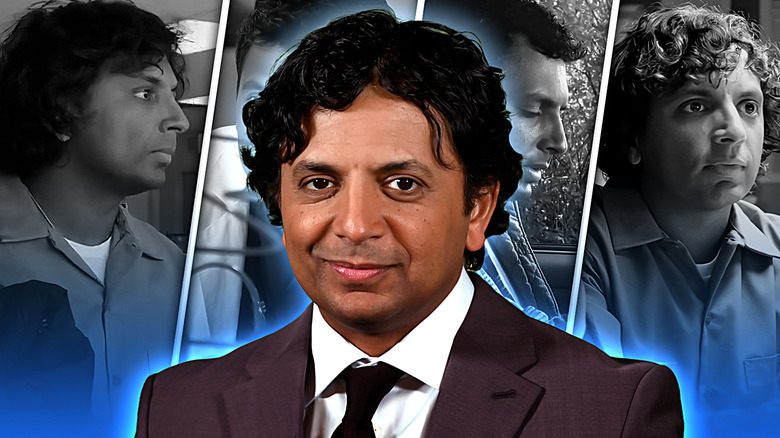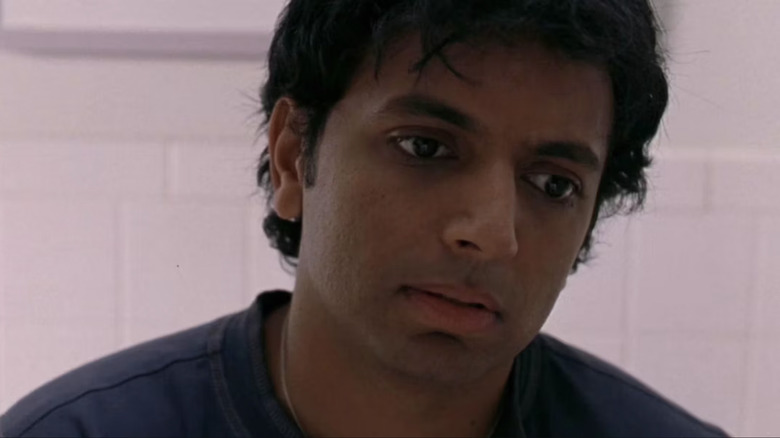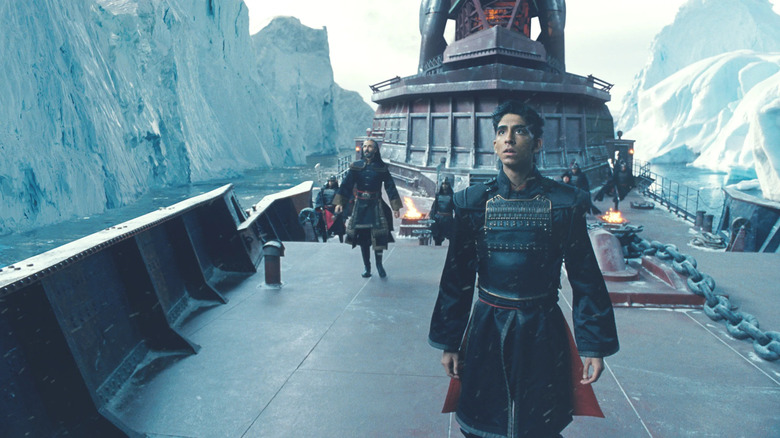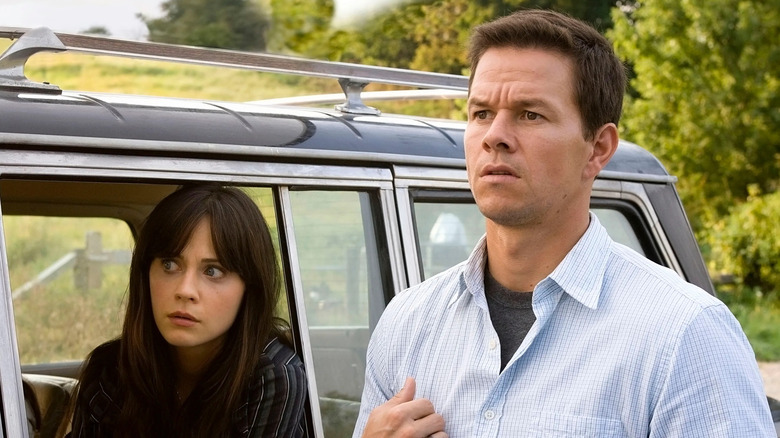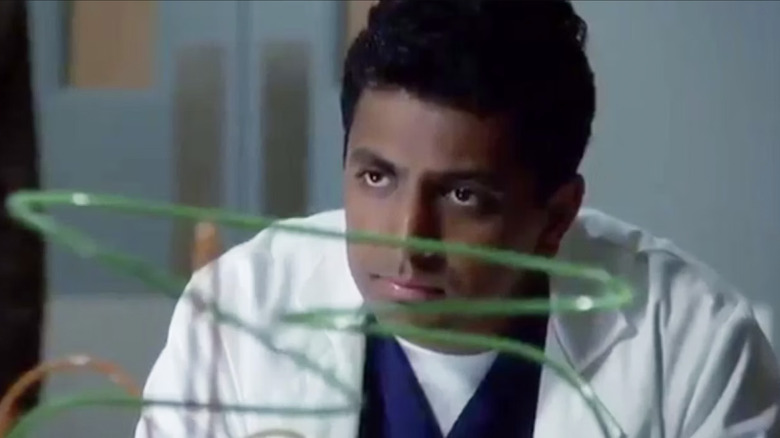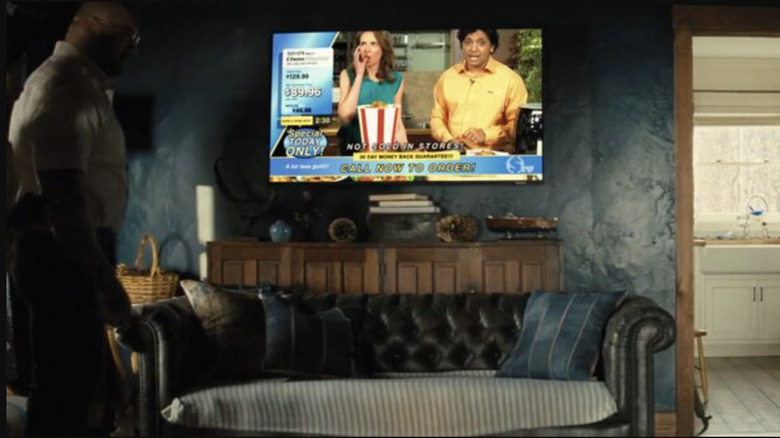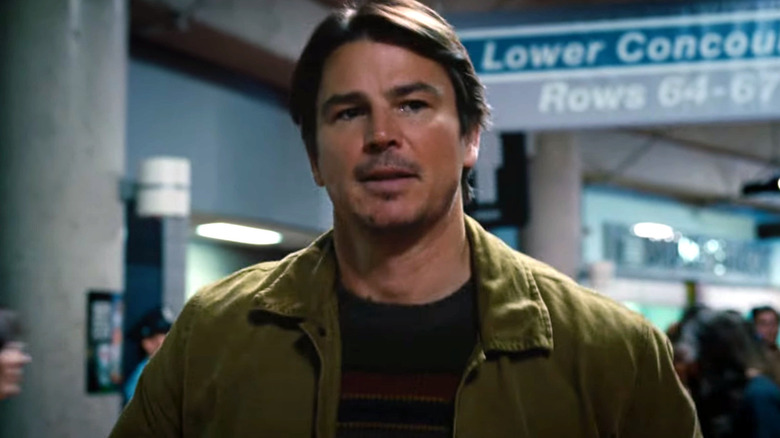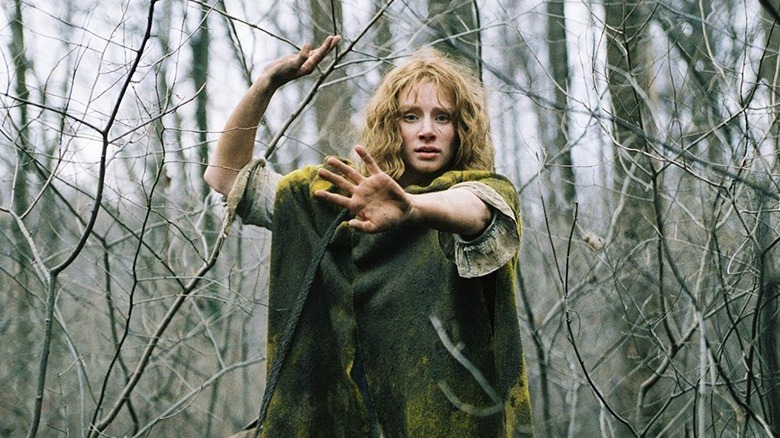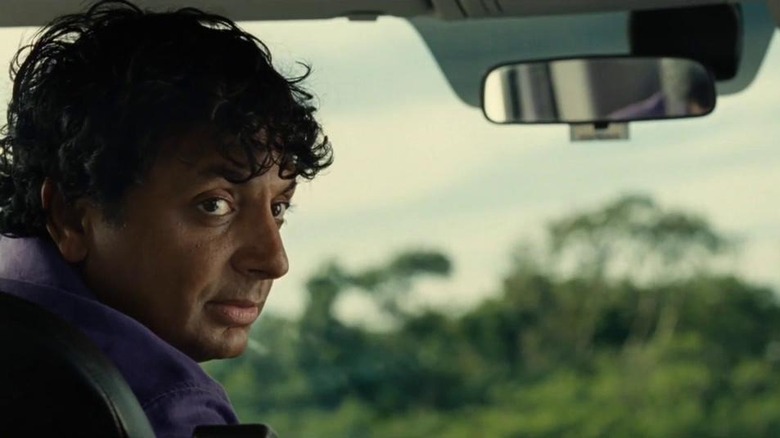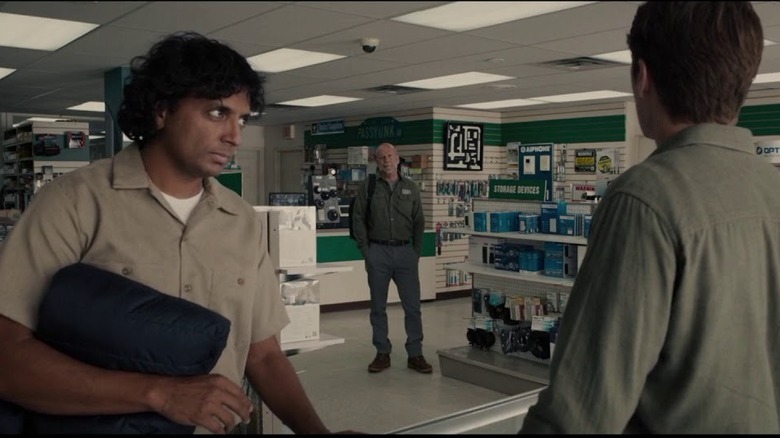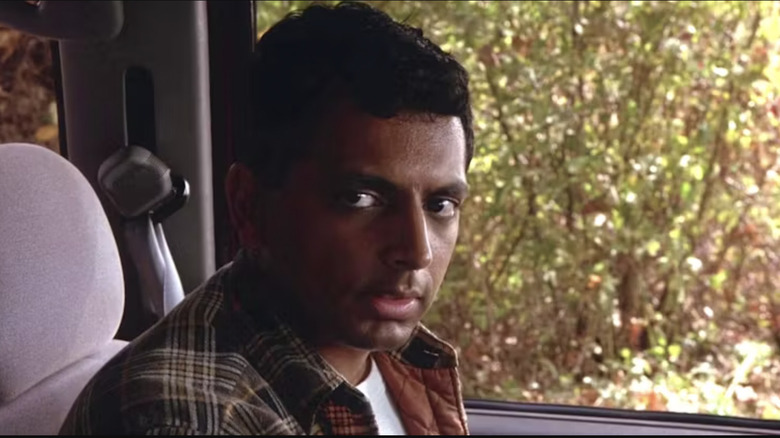M. Night Shyamalan's Cameos In His Own Movies, Ranked
Film directors acting in the films they make is neither rare nor new. Charlie Chaplin and Buster Keaton were doing it during the silent era, and as more artists like Orson Wells, Ida Lupino, John Cassavetes, and now Ben Affleck and Bradley Cooper got into the act (literally), it's hardly surprising for audiences to see a movie written by, directed by, and starring the same person.
However, there also exists the parallel concept of the director's cameo, which is distinguished from the acting directors because the concept of a cameo itself is an elastic idea — ranging from a brief, non-verbal appearance to an entire supporting role. Unlike a filmmaker playing the lead or a co-lead in their own feature, a director making a cameo appearance in their own film tends to have a meta aspect to it: they know you know who they are, so their appearance in and of itself is either a cheeky wink at the audience or a bold underlining of one of the movie's major themes or ideas.
It's in this spirit that M. Night Shyamalan's cameo appearances in his own films belong to. Although Shyamalan exhibits a little bit of Frustrated Actor Syndrome (which Quentin Tarantino has a full-blown case of), his cameos tend to have several layers to them beyond just visual recognition. While not every one of his appearances has been successful or worthwhile, they have undeniably contributed to the filmmaker's distinctive signature. Just like the high concept narratives and twists, part of the fun of a new Shyamalan movie, like this month's "Trap," is seeing where and how he turns up.
10. Lady in the Water: Vick Ran
A good place to start with this ranking is getting the obvious stuff out of the way first. For one thing, three Shyamalan movies — "Wide Awake," "After Earth" and "The Visit" — will not be showing up here, for the obvious reason that Shyamalan does not make a cameo in any of them. For another, his first film, "Praying with Anger," doesn't quite qualify for this article, because although he's in the movie, he's in the lead role, which can hardly be called a cameo.
Finally, his least successful cameo is unsurprisingly from his infamous "Lady in the Water," the movie that sees Shyamalan at his most self-reflexive and reactionary. The film sees Cleveland Heep (Paul Giamatti) discover a magical being literally named Story (Bryce Dallas Howard) living in his apartment building, whose mission is to find a prophesied Writer who will author a book that will save all of humanity. That Writer? None other than Vick Ran, played by Shyamalan himself.
Shyamalan's performance as Ran is almost beside the point, given the blatant and thinly veiled double meaning of his role and the film as a whole. By casting himself as the brilliant artist-savior of humanity, as well as including a haughty film critic character (played by Bob Balaban) who gives the heroes bad advice, Shyamalan manages to outdo the pettiness exhibited by Roland Emmerich's inclusion of Siskel and Ebert lookalikes in 1998's "Godzilla." As always, you gotta admire Shyamalan's chutzpah, but hoo boy, what a misstep.
9. The Last Airbender: Firebender at Earth Prison Camp
One thing that can be said for "Lady in the Water" is that it's at least substantial and knows what it's trying to do, which is something that cannot be said for another Shyamalan mishap — the live-action adaptation of the animated "The Last Airbender" series (which dropped the "Avatar" title due to a certain James Cameron movie that released months earlier).
Although Shyamalan's ambition was once again on display in his attempt to adapt the beloved animated series to the big screen, the film ended up being one of those adaptations that disappointed both hardcore fans and general audiences alike, so much so that two planned sequels were scrapped and a re-envisioned live-action series premiered on Netflix earlier this year (with similarly mixed if not as disastrous results).
Despite giving such a large-scale franchise production a try, perhaps Shyamalan was already feeling wary of the work while making it, for his cameo appearance is surprisingly vague. He's listed as "Firebender at Earth Prison Camp" on IMDb, yet it's not clear which Fire Nation prison guard he is. He's presumably in the scene where Dev Patel's Prince Zuko springs the titular last Airbender, Aang (Noah Ringer), from jail. I suppose his appearance is like the good movie lurking inside "The Last Airbender": it's there if you squint.
8. The Happening: Joey
You may be thinking to yourself that it's some sort of bias that Shyamalan's three most notorious movies (save the Smith Family Robinson movie, "After Earth") make up the bottom three entries on this ranking. Yet perhaps it's not a coincidence; maybe the filmmaker's heart just wasn't as in these movies as it was in others, and his cameos in each reflect that.
As evidence: Shyamalan's appearance in "The Happening" isn't an appearance per se. He plays the voice-only role of Joey, the erstwhile paramour of Alma (Zooey Deschanel), who is now married to high school science teacher Elliot Moore (Mark Wahlberg). Throughout the film, Joey tries to call Alma on her cell as the outbreak of mass suicides caused by certain toxins that the world's plants begin releasing spreads. It's a classic "Hey, the world seems to be ending, been thinking about how things ended with us, too" ex-boyfriend move, and not only is Joey unsuccessful, but he's also never seen. Perhaps he ends up surviving the outbreak, and maybe he finally finds love, too. Perhaps with the hot dog guy? We can only dream.
7. The Sixth Sense: Dr. Hill
"The Sixth Sense" was not only Shyamalan's first hit film, but it's arguably his masterpiece, a movie that both works and delivers on multiple levels. One of the most impressive elements of the movie, which sees young Cole Sear (Haley Joel Osment) and child psychologist Malcolm Crowe (Bruce Willis) dealing with Cole's supernatural ability to see the spirits of the dead, is that it's as economical as it is ambitious. There's not a wasted second in the movie and even elements and subplots that may seem like digressions on the first watch reveal themselves to have intriguing new meanings when all is finally revealed.
Sadly, Shyamalan's innate sense of structure and timing when it comes to this movie meant that his cameo appearance had to suffer. He portrays Dr. Hill, a pediatrician trying to treat the troubled Cole, and originally his role was bigger. Although he'd hoped that playing the doctor would act as a tribute to his parents (who were physicians themselves), Shyamalan felt that most of the scenes featuring Hill could be cut, and thus they were. Perhaps it was this notion of a tribute to his mother and father that found Shyamalan disapproving of his performance, but maybe it was just a byproduct of the filmmaker's senses being at their sharpest.
6. Knock at the Cabin: Infomercial Host
Shyamalan's cameo in "Knock at the Cabin" is very short, but its brevity doesn't impede its impact. Nor its cleverness, either; given the single-location premise of the film. A group of cult-like strangers arrive at a secluded cabin and tell the two men and their daughter who are staying there that they need to sacrifice one of their family members to prevent the apocalypse, so Shyamalan couldn't insert himself into the movie too easily.
Sure, he could've made himself one of the news anchors that pop up during the several moments where the leader of the invaders, Leonard (Dave Bautista), turns on the television to show his captives how their lack of sacrifice is supposedly causing multiple apocalyptic incidents to occur around the world. Instead, he appears as the host of an infomercial for an air fryer, something everyone in the cabin is eager to click away from in order to get to the news. The cameo works as a cheeky wink to the audience in a very Hitchcockian manner, yet it also provides a moment of not just levity but mundanity. In a movie that asks its characters and its audience to buy into some pretty improbable things, having something as ordinary as an infomercial for an air fryer on TV keeps things grounded enough that it becomes that much easier to believe what's happening is really happening.
5. Trap: Spotter
Shyamalan's latest film, "Trap," is a tightly plotted thriller involving Cooper (Josh Hartnett), who is secretly a prolific serial killer known as The Butcher. He's known for getting into situations where he's about to be caught only to slither his way out of them, mostly due to his savvy and intelligence. He finds himself trapped in a pop concert given by Lady Raven (Saleka Shyamalan) with his daughter, Riley (Ariel Donoghue). As the FBI and other authorities surround the arena, Cooper learns from Riley that Lady Raven always chooses a member of the audience for a certain song at her shows and that this lucky person and their family get to go (and then leave) from backstage, where the cops supposedly aren't.
Seeing a man with backstage clearance watching the show, Cooper sidles up to him. Turns out the Spotter, played by Shyamalan, is Lady Raven's uncle, and is in charge of picking a lucky girl from the audience for the big song. Cooper slyly introduces the idea that his daughter just recently recovered from leukemia, which instantly pulls at the proud uncle's heartstrings.
While this appearance doesn't quite reach the levels of cleverness that the following cameos do, it's still very sly in its meta-ness; not only does Shyamalan get to fawn over his actual child's performance, he also gets to help out another Girl Dad, thereby becoming part of his own character's solution to the predicament that he put him in.
4. The Village: Guard at Desk
Ah, now we're getting into some primo Shyamalan meta-ness. Where the immaculate run of "The Sixth Sense," "Unbreakable," and "Signs" made a case for the filmmaker being a successor to Rod Serling (at least when it came to weaving genre narratives that functioned on multiple levels), "The Village" sees Shyamalan start actively playing around with his audience's expectation for a big, climactic twist. In other words, where the twists of his previous three films felt also acted as huge emotional payoffs, the "gotcha!" finale of "The Village" is much more of a rug pull.
Yet that switcheroo goes down much more smoothly given the delicious satiric aspect of the twist, which is that the 19th-century story we thought we were watching has actually been set in the 21st century all along. As Ivy (Bryce Dallas Howard) leaves the historical preserve that she's a member of and runs into some park rangers who help keep the place isolated and patrolled, Shyamalan plays one of the rangers whose face is seen in reflection after he helps deliver some twist-explaining exposition. If a case for Shyamalan-as-Serling could be made, this is the touchstone example.
3. Old: Hotel Van Driver
The bulk of Shyamalan's cameo appearances tend to be walk-on roles, small supporting bits that don't require much from him on camera. Yet Shyamalan seems to have the most fun when he gives himself material to chew on. While the Hotel Van Driver from "Old" isn't even blessed with a character name, he makes a pretty big impact on the story in both a literal and meta sense.
In "Old," Shyamalan plays the man whose job is to drive tourists from an exclusive resort to a certain isolated beach, and it initially seems that his appearance early in the film will be one of his many short cameos. Yet he doesn't just deliver his ensemble of characters to their bizarre fate — rapidly aging while trapped on the beach — he's also tasked with monitoring these victims, keeping tabs on them for purposes of lifelong drug trial experiments conducted in a day. Thus, not only is M. Night playing a villain, and not only is he present to help explain the twist (as in "The Village"), but he's also cast himself as the passive observer of these characters, aka the director. A dastardly mastermind, that M. Night!
2. Unbreakable/Split/Glass: Jai
"Unbreakable," "Split," and "Glass" are Shyamalan's only sequels (let alone trilogy) to date, and part of the fun was watching them develop and unravel. Heck, the fact that "Split" was even a sequel to "Unbreakable" at all was that movie's twist. While these movies have a lot on their minds beyond just superheroics, the saga of David Dunn (Bruce Willis), Elijah Price (Samuel L. Jackson), and Kevin Wendell Crumb (James McAvoy) doubles as Shyamalan's clever riff on comic book lore, including the idea of an ever-evolving shared universe.
To that end, his appearances in each film turn out to be more than the sum of their parts. Initially appearing in "Unbreakable" as someone who David uses his powers on and discovers is a drug dealer, M. Night turns up in "Split" as Jai, who works as a security guard at the apartment building of Kevin's psychiatrist. When Shyamalan, as Jai, is trying to buy some equipment for his security service in "Glass," he encounters David again, mentioning that he used to hang out with "some shady types" at the football stadium decades ago. Not only is this confirmation that Shyamalan has been playing the same character in all three films, but it also reinforces one of the trilogy's major themes: that superheroes could exist, and they may have the ability to influence the world for evil or for good.
1. Signs: Ray Reddy
While Shyamalan is a hoot when he's pulling off narrative tricks or when he's in horror host-style cheeky mode, he can also be genuinely affecting when he wants to be, and nowhere is that better seen than his showcase role in "Signs." Here, Shyamalan isn't playing around with structure or explaining (or hinting at) any twists: he's 100% on theme, playing Ray Reddy. Ray is the man who was responsible for the car accident that killed the wife of a priest, Graham (Mel Gibson), causing the former to be wracked with guilt and the latter to lose his faith.
As mysterious crop circles and other alien invasion-related shenanigans begin occurring around the land where Graham and Ray live, the two men finally speak to each other. As the talk, Ray makes a moving confession to Graham about his deep-seated guilt over the tragedy, leading to a discussion about the notion of fate which helps prepare Graham for the film's Rube Goldberg-esque final act.
What makes his performance as Ray his best to date is that it reveals the most about Shyamalan the artist: despite the bulk of his films all containing some form of genre trappings, his work is entirely personal and deeply heartfelt. He has always been and will likely always be true to his own muse, and whether you're on his wavelength or not (which can vary from film to film!), that's a rare quality in show business. It's one to respect and cherish.
